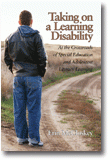
Taking on a Learning Disability
At the Crossroads of Special Education and Adolescent Literacy Learning
By:
Erin McCloskey, Vassar College
Published 2012
In the United States, approximately 2.5 million students are diagnosed as having a learning disability and the majority of those children are placed in special education because of an inability to read as expected. As a result of this diagnosis, these children may be placed in special education classrooms - classrooms that are separate from the ‘mainstream’ population. For children with learning disabilities, there is likely no place, other than in school, where a student’s inability to read as expected leads to this separation from his/her peers. Once school is over, these children play alongside the kids in their neighborhoods, participate in sports teams, and attend community activities. This book looks at the impact of being labeled as learning disabled and separated from peers in school through the eyes of Samson, a middle school student described both as learning disabled and a non-reader. This qualitative case study explores how Samson, his family, his teachers and this researcher make sense of special education and the complexities of learning to read as an adolescent.
Throughout this book, there is a contrasting of the laws and procedures designed to guide special education, with the actual experiences of those impacted by these laws and procedures. Through the three years that Samson was in middle school, this book investigates his perspective on his classes, his interpretation of what it means to ‘be’ a student in special education, and the process by which he learns to read. How disability gets created, contested, and discussed is highlighted through the many contexts that allow disability to be recognized and to fade into the background.
CONTENTS
Preface. Acknowledgments. Chapter 1: Perspectives And Methods: Learning Disabilities and Adolescent Literacy Learning. Chapter 2: A Case History Of Samson and His Family. Chapter 3: Doing School and Having It Done To You. Chapter 4: An Old Disability Improves and A New One Is Constructed. Chapter 5: An Apprenticeship Approach To Adolescent Literacy Learning. Chapter 6: On Graduation Day.
-
Paperback978-1-61735-786-2
Web price: $45.04 (Reg. 52.99)
-
Hardcover978-1-61735-787-9
Web price: $80.74 (Reg. 94.99)
- eBook978-1-61735-788-6

- EDU026000 - EDUCATION: Special General
- EDU026020 - EDUCATION: Special Learning Disabilities
- EDU018000 - EDUCATION: Language Experience Approach
-
 Children With Learning Differences Exploring Artmaking to Address Deficit-Laden Perspectives
Children With Learning Differences Exploring Artmaking to Address Deficit-Laden Perspectives
-
 Contemporary Perspectives on English as a Medium of Instruction
Contemporary Perspectives on English as a Medium of Instruction
-
 Cultivating Democratic Literacy Through the Arts
Guiding Preservice Teachers Towards Innovative Learning Spaces in ELA Classrooms
Cultivating Democratic Literacy Through the Arts
Guiding Preservice Teachers Towards Innovative Learning Spaces in ELA Classrooms
-
 Engaging in Critical Language Studies
Engaging in Critical Language Studies
-
 How We Take Action
Social Justice in PK-16 Language Classrooms
How We Take Action
Social Justice in PK-16 Language Classrooms
-
 Innovative Approaches to Teaching Multilingual Students
Innovative Approaches to Teaching Multilingual Students
-
 Narratives of TESOL Professionals
Experiences Navigating the Doctoral Program
Narratives of TESOL Professionals
Experiences Navigating the Doctoral Program

